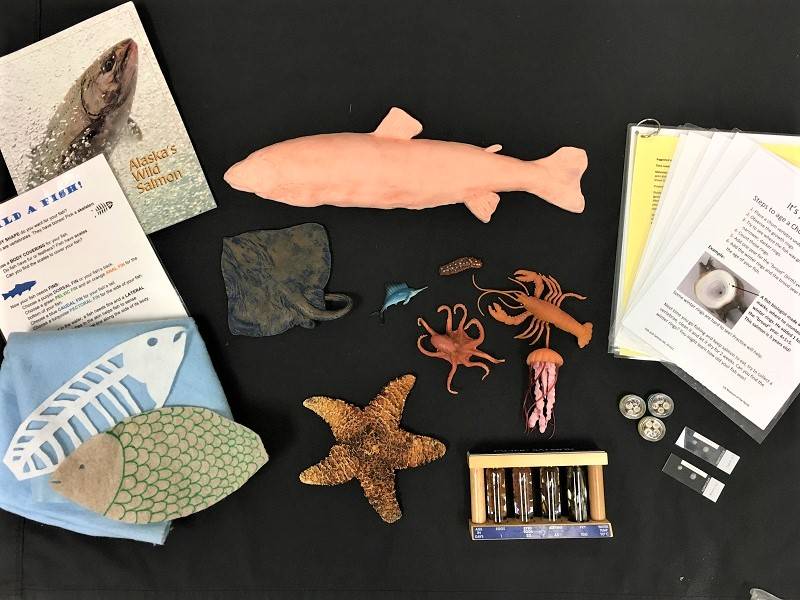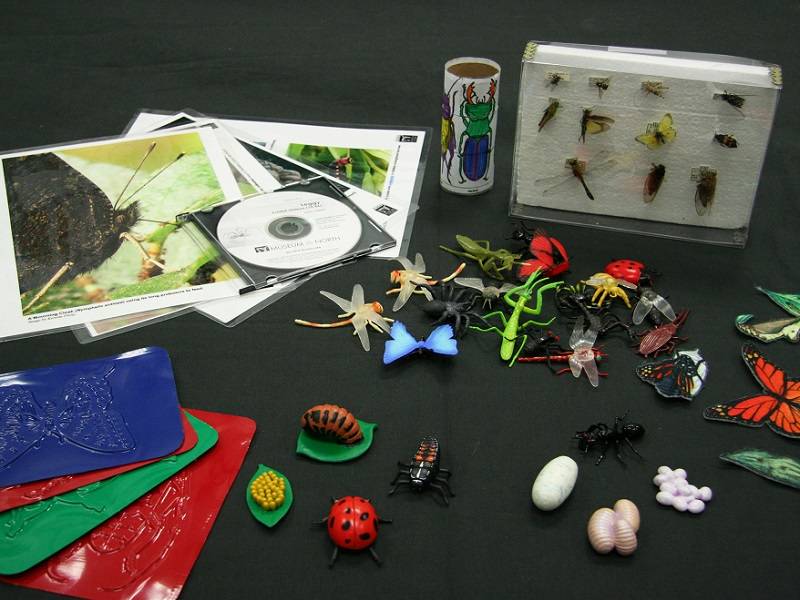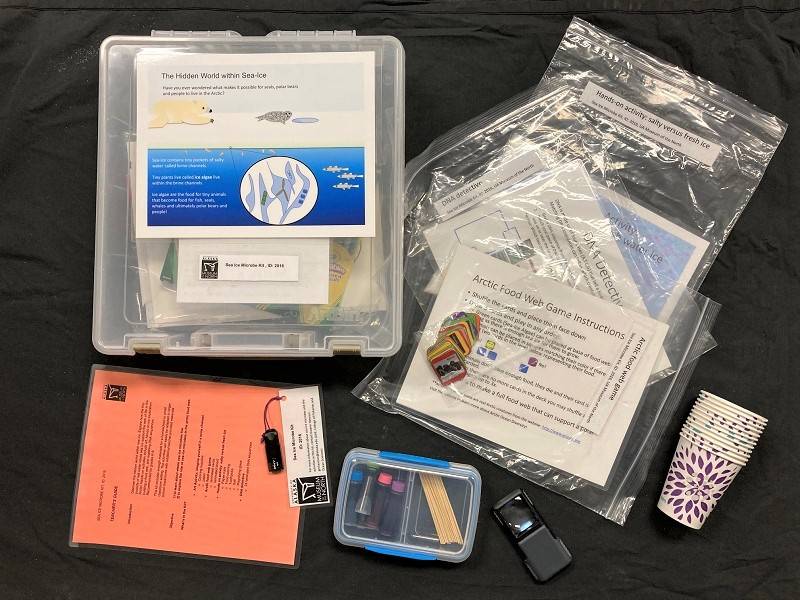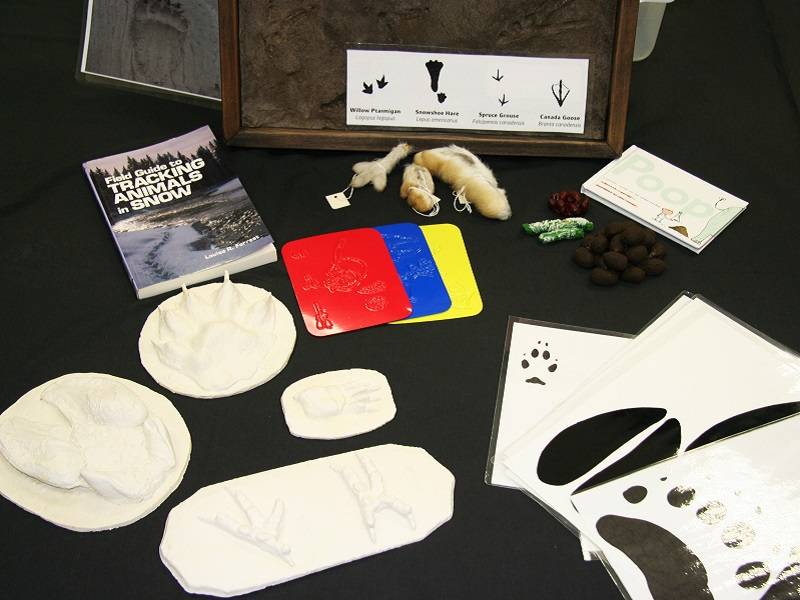Natural History
Individual objects are available to borrow:
- Alaska mammal toys (various plastic figurines)
- Arctic fox pelt
- Beaver pelt
- Beaver skull
- Caribou antler
- Classroom set of bear skulls
- Classroom set of sea otter skulls
- Dall sheep horn
- Lynx pelt
- Moose jaw
- Red fox pelt
- River otter skull
- Sea otter pelt
- Whale baleen
- And more; if you are looking for a specific object, contact us at ua-museumlearn@alaska.edu.
Click on any picture to enlarge it. Images will open in a new window.
 Berries are important to Alaska’s people, Indigenous cultures, and ecosystems. Explore
the diversity of berry species, learn to interpret data in the context of a changing
climate, and gain a deeper understanding of berry traditions in Alaska. Activities
include identifying and observing berries, listening and telling berry stories, exploring
Alaska Native berry traditions, gathering and interpreting data through UAF Winterberry
Citizen Science, experimenting with hands-on berry science, and more.
Berries are important to Alaska’s people, Indigenous cultures, and ecosystems. Explore
the diversity of berry species, learn to interpret data in the context of a changing
climate, and gain a deeper understanding of berry traditions in Alaska. Activities
include identifying and observing berries, listening and telling berry stories, exploring
Alaska Native berry traditions, gathering and interpreting data through UAF Winterberry
Citizen Science, experimenting with hands-on berry science, and more.
What’s in the Kit?
Berry Picker object
Koo-me-yuon (Berry Picker) object
Coiled grass basket object
Beach grass objects
Birch Bark Basket object
Pressed Plant specimens (6) objects
Watercolor color pencils & sharpeners
Writing boards
Refillable brushes
Magnifying lenses
Digital Microscope
Mini Voice Recorders & Speaker
Field Plant Press
Vitamin C Test Kit
Make Electricity Science Set
Collection containers, mesh bags, & petri dishes
Mashers & sieves
Puppets (Bears, Ravens, Bees, Butterflies, Robins, Squirrel, Fox, Laminated Berries)
Felt mats
Felt shapes, plants, and animals
Guess Which Berry? cards
Berry Matching Game cards
Berry Bingo game
How Are Your Berries? sorting cards
Interwoven Expressions booklet
Batuk’enelyashi booklet
Earth Dyes booklet
Plants That We Eat book
Alaska’s Wild Berries and Berry Like Fruit book
Alaska Wild Berry Guide and Cookbook book
Berry Magic (4) books
Berry Song book
Berry Puzzle
Binder: STEAM Activities & Information
USB Drive
Recommended grade levels: K-12
Key words: Alaska Native Cultures; Berries; Citizen Science; Climate Change; Plants; Seasons;
Subsistence
Borrow Kit
Return to Kits Homepage
Alaska Marine Mammals Kit
 Discover a diversity of Alaska marine mammal species, including whales, walruses,
sea otters, seals, polar bears, and more. Investigate the importance of marine mammals
to the ocean ecosystem and their conservation history. Explore the cultural importance
of marine mammals to the Indigenous peoples of Alaska. See and touch hands-on museum
specimens and cultural objects.
Discover a diversity of Alaska marine mammal species, including whales, walruses,
sea otters, seals, polar bears, and more. Investigate the importance of marine mammals
to the ocean ecosystem and their conservation history. Explore the cultural importance
of marine mammals to the Indigenous peoples of Alaska. See and touch hands-on museum
specimens and cultural objects.
What’s in the Kit?
Baleen basket object
Iñupiat mukluks object
Fur and wood boat model object
Yo-Yo object
Bear carving object
Ivory walrus carving object
Ivory polar bear carving object
Walrus tusk carving object
Bola object
Sealskin sewing thimble object
Sealskin hat object
Baleen object
Sea otter skulls (9) objects
Sea otter vertebra object
Polar bear pelt object
Harbor seal skull replica object
Krill object
Walrus tusk object
Walrus tooth object
Orca tooth object
Marine mammal plastic replicas (15) objects
Whale & sea otter puppets objects
Whale Jenga activity
Wire hangers
Hand-held mirrors
Calipers
Flagging Tape
Meltdown DVD
Arctic Currents DVD
A Guide to Marine Mammals of Alaska book
About Marine Mammals book
Whales book
What If There Were No Sea Otters? book
The Polar Bear book
Sea Baby: A Little Otter Returns Home book
Alaska Eskimo Whaling Commission booklet
Keeper of the Seal book
Kukugyarpak book
Kayak Design Curriculum book
Binder: Suggested Activities
Binder: Marine Mammal Species Information
USB Drive (2): What a Whale Hears
USB Drive: Information and Activities
Recommended grade levels: preK-12
Key words: Adaptations; Alaska Native Cultures; Arctic; Conservation; Iñupiat; Marine Mammals;
Sea Otters; Seals; Polar Bears; Walruses; Whales; Yup'ik
Borrow Kit
Return to Kits Homepage
 Beaver Kit
Beaver Kit
Learn about the largest rodent in North America. Practice observation skills and investigate the physical characteristics and adaptations of beavers by examining skulls, feet, fur, and teeth. Discover how to recognize indirect sign (tracks, scat) and learn about beaver habitats.
What’s in the Kit?
Beaver pelt object
Beaver skull object
Beaver claw object
Chewed beaver stick object
Track stencil object & activity
Beaver footprint mold (front & rear) object & activity
Beaver footprint cast object
Beaver scat replica object
Beaver plastic figurine object
Beaver info sheets and features cards
Beaver tail pastry recipe
Build a beaver lodge activity
Recommended grade levels: preK-12
Key words: Adaptations; Beaver; Habitats; Mammals; Rodents; Tracking
Borrow Kit
Return to Kits Homepage
 Camouflage & Natural Selection Kit
Camouflage & Natural Selection Kit
How many insects can you see? Can you spot the fish? Why do hares and ptarmigans change color? In this kit you will find games and artifacts to support discussions about camouflage and to introduce the concepts of natural selection and adaptation.
What’s in the Kit?
Willow ptarmigan wings (2) objects
Willow ptarmigan foot object
Snowshoe hare pelts (winter & summer) objects
Natural selection game: “Eat Them All” activity
Hide-and-Seek cards activity
“Master of Disguise” Butterfly activity
Adaptation and Natural Selection info sheets
Feathered Snowshoes and Color Adaptation info sheets
Animal Disguises book
Recommended grade levels: K-5
Key words: Adaptations; Camouflage; Mimicry; Natural Selection
Borrow Kit
Return to Kits Homepage
 Compare the Bear
Compare the Bear
What are the differences between a grizzly bear skull and a polar bear skull? Do the differences tell us anything about their diet or the environment they live in? Using observations and measurement, students will compare two bear skull replicas. From a simple comparison activity to a more complex skull and jaw measurement activity, this kit can be used in a variety of ways.
What’s in the Kit?
Grizzly bear skull object
Polar bear skull object
Polar bear fur object
Polar, grizzly and black bear claw replicas object
Measure and Compare activity
Skull and jaw Comparison activity
Calipers
Grizzly and Polar Bears info sheets
Alaska’s Bears book
Recommended grade levels: 2-12
Key words: Black Bear; Claws; Grizzly Bear; Measurement; Polar Bear; Skull
Borrow Kit
Return to Kits Homepage
 DNA and Genomics
DNA and Genomics
Explore DNA and genomics through hands-on activities. Discover what has DNA, build DNA models, and extract DNA. Learn about data sampling, marine mammals, and conservation genetics.
What’s in the Kit?
DNA Model Kit
RNA Model Kit
Bags of objects [What Has DNA? Activity]
What Has DNA? cards
Laminated Chromosome Strips [Genetic Traits: Build-A-Dog Activity]
Sand Bottles [eDNA Search and Find Activity]
Laminated Materials [eDNA Search and Find Activity]
Dry erase markers
Test tubes with lids
Pipettes
Beakers
Squirt bottles
Small measuring cups
Binder: Suggested Activities
USB Drive
Recommended grade levels: 1-12
Key words: Conservation; DNA; Genes; Genetics; Heredity; Genomics; Marine Mammals; RNA
Borrow Kit
Return to Kits Homepage
 Fish & Salmon Kit
Fish & Salmon Kit
What are the different parts of a fish? How do salmon live? This kit offers an general introduction to fish, with a focus on Pacific salmon. Students will also discover how to determine the age of a fish using vertebrae, otoliths, and scales.
What’s in the Kit?
Build a Fish activity
Find the Fish activity
Sea Star object
Gyotaku Fish Print suggested activity
Aging Fish information and suggested activity
Sockeye salmon scales objects
Perch scales objects
Burbot otoliths objects
Chum salmon vertebrae objects
Salmon Mold object
Ident-I-Cards activity
Pacific Salmon Life Cycle display
Pacific Salmon Life Cycle Wheel activity
Salmon Stages poster
Fun Fish Facts cards
Alaska’s Wild Salmon book
Otolith Information
Recommended grade levels: K-6
Key words: Fish Identification; Fish Print; Gyotaku; Life Cycles; Salmon
Borrow Kit
Return to Kits Homepage
 Insects Kit
Insects Kit
What distinguishes insects from spiders or crabs? This kit explores what makes an insect and looks at some specialized features such as mouths and legs. Field activities are included to help your class observe real insects year round.
What’s in the Kit?
Ten insect orders (in resin) objects
Dragonfly life cycle (in resin) objects
Insect life cycles: Ant, Ladybug, Mosquito objects
Butterfly felt life cycle objects
Is It An Insect? activity
Arthropods vs Vertebrates Ratio activity
Metamorphosis/ Life Cycle Mobile activity
Make an Insect Spinner activity
Who’s My Insect? activity
Insect Rubbing Plates activity
Pressed Butterflies (32) objects and activity
Live Observations & Field Activities suggested activities
Includes nets, tweezers, trowels, magnifying glasses,
plastic containers, ice cube trays, and leaf litter trap model
Arthropod plastic figures (33) objects
The Insect Class book
Eyewitness Books: Insects book
The Small Majority book
The Icky Bug Alphabet book
Leggy Exhibit Videos DVD
Fossilized Insects picture
Digital Microscope
Recommended grade levels: preK-5
Key words: Adaptation; Arthropods; Insects; Life Cycles; Taxonomy
Borrow Kit
Return to Kits Homepage
 Lynx Kit
Lynx Kit
Discover an elusive predator of Alaska’s boreal forests! Experience hands-on discovery of real skulls with this classroom set. Learn about the life history and behavior of lynx. Find out how lynx and snowshoe hares depend on each other. This kit offers resources and choices of games and hands-on activities for a broad range of grade levels.
What’s in the Kit?
Lynx skulls (15) objects
Lynx pelt object
Snowshoe hare skull object
Life size lynx cutout object
Calipers
What is a Lynx? info & resource sheets
Skull Anatomy activities
Lynx Diet Games activities
Animal Skulls: A Guide to North American Species book
Recommended Grade Levels: 2-12
Key words: Diet; Lynx; Measuring; Skull, Snowshoe Hare
Borrow Kit
Return to Kits Homepage
 Sea Ice Microbe Kit
Sea Ice Microbe Kit
Discover the hidden world within sea ice! Explore how the tiny pockets of salt water inside sea ice support the web of life in the Arctic. Hands-on activities include art, ice exploration, building a food web, and matching DNA sequences.
Note: This kit includes enough materials for a small classroom or homeschool setting. The activities can easily be adapted to larger classrooms with additional teacher-provided materials.
What’s in the Kit?
Imagine Yourself in a Brine Channel art activity
Coloring supplies, paper
Arctic Food Web Game activity
Laminated cards and board
Salty vs Fresh Ice activity
Paper cups, food coloring, toothpicks, salt, magnifying glass
DNA Detective activity
24 laminated DNA sequences
Recommended grade levels: K-6
Key words: Arctic; Food Web; Microbes; Sea Ice
Borrow Kit
Return to Kits Homepage
 Tracks & Scat Kit
Tracks & Scat Kit
Looking at tracks is a great way to detect many animals. Learn about indirect sign and practice reading the stories left behind by animals. Become familiar with the tracks and scat of some Interior Alaska animals through hands-on activities.
What’s in the Kit?
Tracking Board object
Snowshoe Hare Feet objects
Ptarmigan foot object
Beaver-chewed stick object
Fox and Wolf Fur Tufts objects
Animal Scat Replicas (Bat, Beaver, Black Bear, Goose, Grouse, Marmot, Moose, Porcupine,
Red Fox, River Otter, Squirrel, Wolf) objects
Alaska Animal Track Casts (15) objects
Track Stencils (Gray Wolf, Great Horned Owl, Grizzly Bear, Polar Bear)
Animal Track Rubbing Plates (16)
Track ID Challenge activity
Track Dough Recipe and Cast Your Track activities
Who Dung It? activity
Track It Out activity
Tracking Story activity
Brown Cloth with Black Tracks
Laminated Cards
Animal Tracks: What Do They Reveal? activity
Alaska Tracks Guide info sheets
Poop book
Field Guide to Tracking Animals in Snow book
USB Drive
Note: You can also borrow our snowshoes and/or binoculars for an outdoor tracking experience!
Recommended grade levels: K-12
Key words: Animals; Field Study; Scat; Sign; Tracks
Borrow Kit
Return to Kits Homepage
Tree Ring Discovery Kit
Learn about how trees grow and what tree rings can tell us. Challenge your students to analyze patterns of growth in trees and identify evidence of environmental conditions such as fire or drought. Included are enough tree rounds for each student (class of 30) from Western North American trees. Developed by Acorn Naturalists.
What’s in the Kit?
Tree Rounds objects
Arizona Black Walnut (5)
Fremont Cottonwood (5)
Velvet Ash (5)
Emory Oak (5)
Tamarisk (5)
Ponderosa Pine (5)
The Tree Ring’s Tale book
Familiar Trees of North America West book
Tree Ring Discoveries suggested activities
Species ID Cards pictures
Magnifying glasses
Alaska Species Supplement
White Spruce Rounds (11) objects
Alaska Paper Birch Rounds (11) objects
Alaska Tree Trivia Cards activity
Common Trees of Alaska (4) booklets
Tree Rings: Living Records of Climate (EPA activity) suggested activity
Trees and Shrubs of Alaska book
USB Drive
Recommended Grade Levels: 2-8
Key words: Botany; Climate; Dendrochronology; Trees; Tree Rings
Borrow Kit
Return to Kits Homepage

